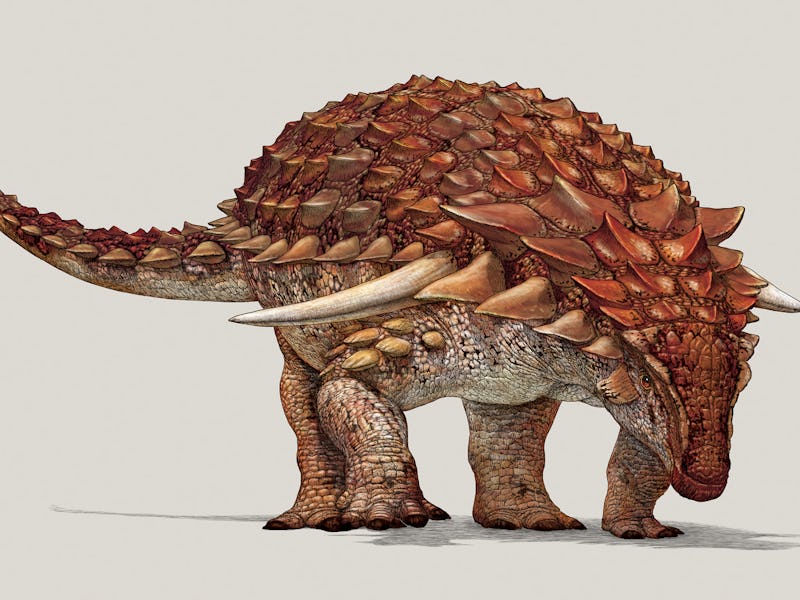Geochemical Testing Shows This Dinosaur Was a Ginger
This is the best preserved armored dinosaur in the world.

In 2011 a heavy machine operator in a Canadian oilsands mine struck his shovel on an extraordinary find — the most exquisitely preserved armored dinosaur the world has ever seen.
On Thursday, it became official: Alberta’s famous nodosaur was a ginger.
“No comparison — this is the best dinosaur I’ve ever worked on,” says Caleb Brown, a paleontologist with the Royal Tyrrell Museum in Drumheller, Canada, and the lead researcher of the study published in Current Biology. The armored dinosaur likely died in a flood and was swept out to sea, eventually sinking and landing on its back on the seafloor. There, a chemical reaction built a rocky tomb around the animal, strong enough to preserve the dinosaur, including skin and stomach contents, for 110 million years.
The astounding level of preservation allows for analyses that have never been done before on a dinosaur of this size, including geochemical investigation of the skin that offers insights into pigmentation. “Dinosaur color has historically been in the realm of imagination; it was always said that we wouldn’t know what color these animals were,” Brown tells Inverse.
The dinosaur was preserved in extraordinary detail.
That’s changed in the last decade, largely thanks to small, feathered dinosaurs found beautifully preserved in China. Researchers found melanosomes — tiny organelles in feathers and skin that are responsible for producing pigments. Because the shape of the melanosome corresponds to a specific pigment, it’s possible to know what color the animal was.
Brown and his team of researchers didn’t find melanosomes in the petrified skin of this nodosaur, which they officially named Borealopelta Markmitchelli. So they turned to geochemical analysis with a mass spectrometer to unlock the actual chemical composition of the skin.
What they found was an abundance of a chemical called benzothiazole, which is produced by the breakdown of pheomelanin, which is the pigment that gives redheads their reddish hair color. The research shows that rusty red was at least one component of the nodosaur’s coloration.
*Borealopelta markmitchelli* did battle with the large theropods of its day.
What’s more, the scientists found heavy pigmentation on the animal’s back, fading on the sides to none on the belly. This is evidence that Borealopelta used a common sort of camouflage called countershading. By being darker in areas hit by overhead sunlight and lighter in areas normally in shadow, the animal conceals its three-dimensional shape from predators.
“The fact that we had this in this nodosaur was actual a very surprising result, because this animal was massive,” says Brown. Borealopelta was about 18 feet from snout to tail, and weighed an estimated 1.3 tons. “It’s a huge animal, it’s covered in armor, but yet it still made use of camouflage to hide, presumably from the large predators at the time.”
Which predators? It’s impossible to say, but it might have been an Acrocanthosaurus or something like it — a big theropod carnivore that looks quite a bit like a T. rex, but more of a slasher than a crusher. An adult Acrocanthosaurus could weigh six tons; that’s worth hiding from no matter how much amor you’re packing.
Borealopelta Markmitchelli is on public display now at the Royal Tyrrell Museum.
Abstract: Predator-prey dynamics are an important evolutionary driver of escalating predation mode and efficiency, and commensurate responses of prey. Among these strategies, camouflage is important for visual concealment, with countershading the most universally observed. Extant terrestrial herbivores free of significant predation pressure, due to large size or isolation, do not exhibit countershading. Modern predator-prey dynamics may not be directly applicable to those of the Mesozoic due to the dominance of very large, visually oriented theropod dinosaurs. Despite thyreophoran dinosaurs’ possessing extensive dermal armor, some of the most extreme examples of anti-predator structures, little direct evidence of predation on these and other dinosaur megaherbivores has been documented. Here we describe a new, exquisitely three-dimensionally preserved nodosaurid ankylosaur, Borealopelta markmitchelli gen. et sp. nov., from the Early Cretaceous of Alberta, which preserves integumentary structures as organic layers, including continuous fields of epidermal scales and intact horn sheaths capping the body armor. We identify melanin in the organic residues through mass spectroscopic analyses and observe lighter pigmentation of the large parascapular spines, consistent with display, and a pattern of countershading across the body. With an estimated body mass exceeding 1,300 kg, B. markmitchelli was much larger than modern terrestrial mammals that either are countershaded or experience significant predation pressure as adults. Presence of countershading suggests predation pressure strong enough to select for concealment in this megaherbivore despite possession of massive dorsal and lateral armor, illustrating a significant dichotomy between Mesozoic predator-prey dynamics and those of modern terrestrial systems.